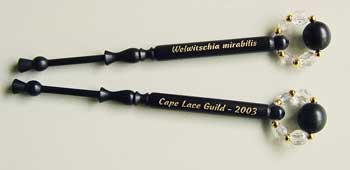
Cape Ironwood at the top. Note the similarity to the grainy wild olive. One can clearly see that both are of the same species "Olea"
Below the ironwood is the Colebrooke ebony. Of the 405 registered pairs made to date (only 500 will be made) most have been in this Midland style. |

Spyrostachys africana
Known as Tamboti (pronounced tum-boo-tea) this a fairly common, but protected, tree that grows over a widespread area in southern Africa. It has a pleasant sweetish odour by which it can be identified with 100% certainty. The oil in the wood is toxic if ingested, although it is reputed that this oil, if the wood is worn up against the skin, will give relief to arthritis sufferers. The smoke is also a hallucinogenic but, unlike cannabis, is not smoked.
It makes nice bobbins but is a difficult wood to work with. |

A Red Ivory "cow 'n calf" with an ebony "calf"
|

This is a gilded Colebrooke bobbin with the date on the one side and "Colebrooke XXX " (the pair number) on the other |

This interesting effect was obtained by "sandwiching" ebony between 2 strips of Red Ivory. Variations are possible by reversing the woods and also using Cape Wild Olive (which is very light in colour with almost no visible grain) together with ebony or Red Ivory. |

Similar effect but with a different design |

My insect, animal and bird bobbins! The red ivory with ebony spots is named after the Ladybird (or Ladybug as I have also heard it being referred to). The centre one (Ironwood with Kingwood spots) is a Cheetah. Two reasons why I have named it as such; Firstly, leopard has broken spots whereas the cheetah has solid ones and, secondly, I make 'em so I name 'em! The bottom one is named a "Guinea Fowl", the bird having blackish feathers with white spots. |

In 2003, the Cape Lace Guild in Cape Town, was requested by the curator of the South African Cultural Museum, to produce a piece of lace which can be placed on permanent exhibition at the museum. It was decided to make a lace reproduction of the Welwitschia mirabilis, a plant which grows in Namib desert. When I heard of this I decided to make this pair of spangled and engraved ebony bobbins and donate it to the Guild. I also turned the two centre beads from ebony. The pair is being shared amongst those lace makers who are involved and once the lace has been completed, the pair will be mounted and exhibited in the same glass case as the lace. |







